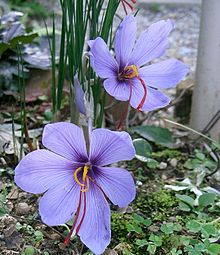

The cultivation of the plant has spanned several millenniums and have been documented in several historical accounts.
Due to its medicinal properties, saffron has been seen to be noted in many accounts and documents referencing several civilizations.
Saffron has been seen to be used as an item of long distance trade and used extensively in textiles.
Chinese accounts state the arrival of saffron between 900-2500 years. It use as a dye was famous throughout South Asia.
It is a perennial plant that flowers in the autumn season. Reproduction mainly occurs with the assistance of humans.
Corm is a bulb like organ of the plant that needs to be dug up and replanted and it survives for about one season. The plant is known to grow up to a height of 30 cm.
The leaves are known as cataphylls that cover and protect the true leaves that are known to expand after the flowers boom.
As the autumn approaches, little purple buds are seen to be formed which develop into full fledged flowers that turn bright hue in colour.
It is known to grow extensively in semi-arid lands with hot summers and breezes.
However the plant could also be grown in the winter season as well with temperatures ranging as low as -10 degree Celsius.
A wet season is important for the crop as rain before the flowering season could improve yields significantly.
plant requires full sunlight conditions and even a slight shade could harm the plant. Planting is done in June in the Northern Hemisphere and leaves are known to develop between October and February.
The soil needs to be loose and well drained with a high organic content. If they are planted on raised beds, such a system could provide better conditions of drainage.
The stigmas of the plant have medicinal qualities are thus used as an aphrodisiac. It is also used for the treatment of stomach ailments. Powdered stigmas have been found to be used by Charaka as a drug in his medical treatises. Saffron threads are used as a flavouring agent in the food industry.
Research studies have shown the presence of carotenoids like crocetin in the stigmas of saffron.
Crocins are responsible for the colouring properties of the plant that are used extensively in the food and processing industry.
Vitamins like Riboflavin and Thiamine, anthocyanins, amino acids, proteins and starch are some other chemical compounds found in saffron.